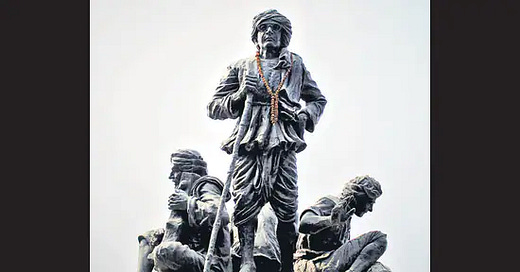Bhikhari Thakur (1887-1971)
The Bard of Bihar whose contributions to folk theatre undercut complex relationships between men and women, tradition and modernity, home and the world. Guest Post by Sudeshna Rana
Bhikhari Thakur was born in Kutubpur village of Chhapra district, Bihar in 1887. Born into the barber caste, a profession he practised in his early life, Thakur went on to establish a drama troupe and began performing Ramlila. His travels to Puri, Kharagpur and Kolkata inspired him creatively and despite having never received any formal education, he became a self-taught performing artist who rose to become a legendary poet, lyricist, playwright, play director, folk musician, and an actor— earning him the title “Shakespeare of Bhojpuri.”
Bhikari Thakur’s plays dealt with social issues and themes of gender, poverty, and most importantly the out-migration of men in colonial India. His play Bidesiya (first staged in 1912) is widely held as the originator of the eponymous genre of bidesiya folk tradition in which the protagonist leaves their families and villages to earn money in the city.
Influenced by Tulsidas’s Ramcharit Manas, he made use of doha and chopai (a variant of couplets and quartets) to the beats of manjeera (hand cymbals), dholak and harmonium. Since the purdah system stopped women from performing on stage, he incorporated the age-old tradition of “launda naach” where female characters were essayed by men dressed in women’s clothing. While upper-caste communities looked down upon his artistry, his plays exuded the power of people’s theatre. Such was the impact of his plays that on many instances’ masses were emotionally moved to end traditional injustices after witnessing his dramatical works.
One such incident is recorded in Sutradhar, renowned Hindi author Sanjeev’s novel on the life of Bhikhari Thakur. In 1964, Thakur’s play Beti Bechwa, which was inspired by real stories of young girls from poor families being sold into marriage to old men, was staged in the Kumardhubi area of Dhanbad district. During one of the shows, more than 500 labourers of the Layakdeeh Colliery marched to a nearby Shiva temple and took an oath that they would never sell their daughters.
Today, his work is considered one of the most vivid glimpses into the lives of the Bhojpuri community of his time. His legacy was kept alive by performers like Padma Shri winner Ramchandra Majhi who was also a member of his troupe. Incidentally, one of his songs ‘Ae Sajni’ was featured in Sudhir Mishra’s Hazaaron Khwaishein Aisi and sung by Swanand Kirkire. Even his popularisation of launda naach is being rediscovered as a South Asian manifestation of queerness. The documentary Naach Bhikhari Naach, from directors Jainendra Dost and Shilpi Gulati, traces the lives of those who inherited his cultural legacy and their dwindling artform in a rapidly modernising India.







